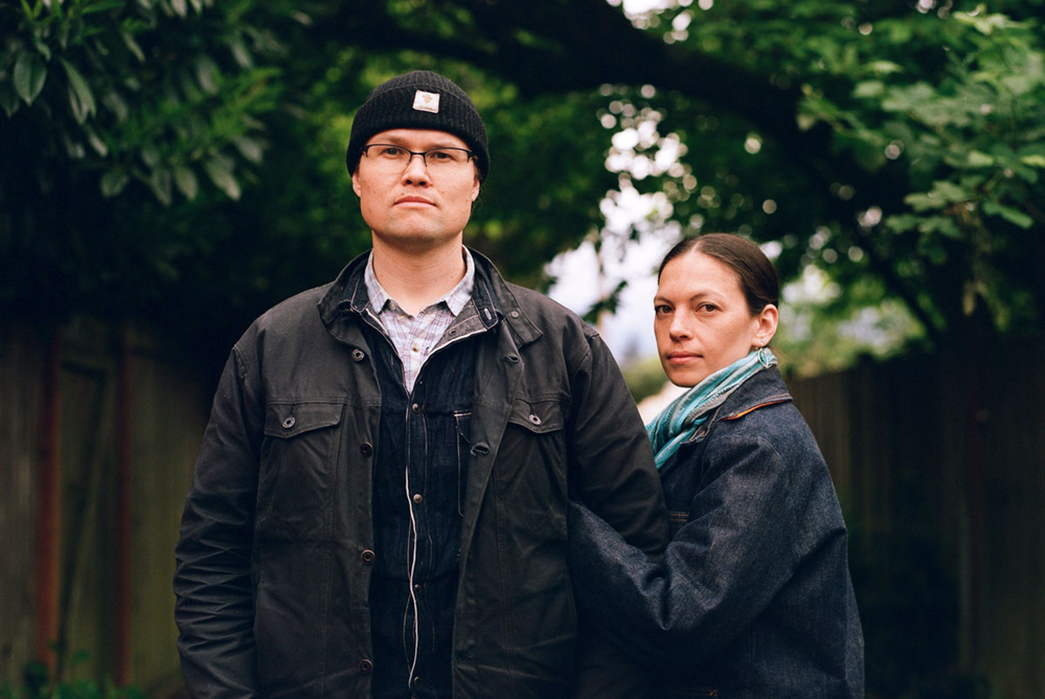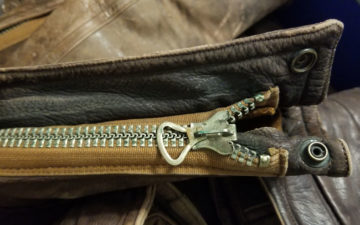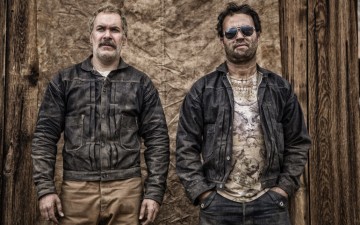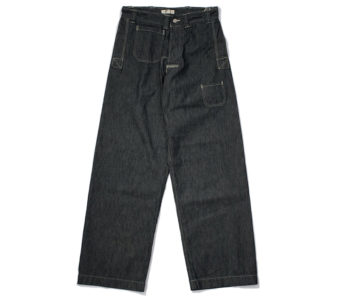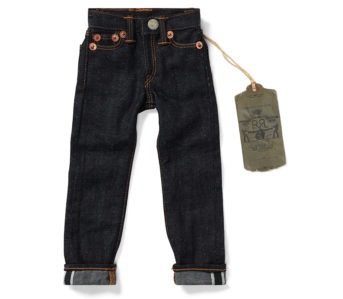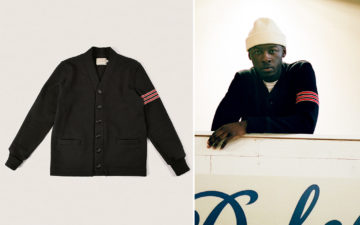
Erik Brodt is one half of the husband and wife duo behind Ginew. Erik and his wife, Amanda Bruegl, have the distinction of running the only Native American-run denim brand in the world. Their infectious enthusiasm and uncompromising perfectionism have manifested in a brand that reproduces classic pieces of Americana folklore in a distinctly Native way.
With Ginew’s newest releases in their final stages of production, Erik happened to be in LA and we sat down for a chat about what makes Ginew special, the origins of deer, and how not to be an appropriative jackass. Throughout our discussion, Erik shared secret details of his signature pieces that I omitted from the interview so they could remain just that— secret. To begin to understand this amazing brand and its designer, read on.
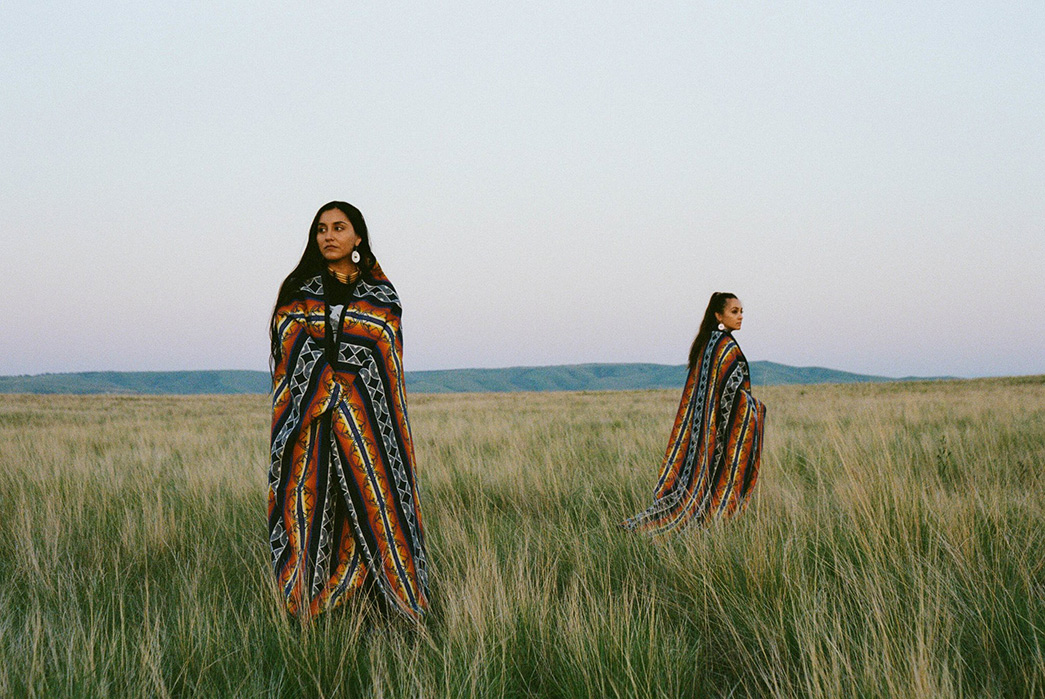
Albert Muzquiz: My first question is super basic. Tell me about Ginew.
Erik Brodt: Ginew is my name. My given Western or Christian name is Erik. Part of my Ojibwe name is Ginew. In Ojibwe, Ginew means brown or golden eagle.
AM: How long has the brand existed?
EB: 8 years. Amanda and I began Ginew in 2010 and we’ve slowly grown since then. We started out doing mostly leather goods as we prepared for our wedding. My dad shot our wedding buffalo, then we stretched it, fleshed it, and did all the tanning in our parent’s garage. We chose to make gifts for the wedding party using the wedding buffalo hide.
I was apprenticing in Houston on my days off to improve the leatherwork skills I had learned as a kid. One day a guy walked into the studio, heard I was working with buffalo hide and flat out asked, “do you have an extra one of those? I’ll give you $200 for it right now.” And then that’s when we started creating and selling leather goods.
AM: What was the next step for you guys?
EB: The next step was apparel. We got into apparel not much later. We began to look much closer into how things are made. I started to think about how I was as a consumer and how I wanted to start having things more thoughtfully curated. I thought back to my dad and my grandpa and how they wore their garments for a long time. My dad still has these hardcore winter jackets that he wore when I was a kid. He still wears them!
AM: So, a simpler wardrobe with these pieces that last.
EB: Yeah, really thinking about what you have in your wardrobe. Everything that comes in by intention. At that time I was trying to find a certain jacket that fit a vibe and a style, but I couldn’t find one made in the U.S. and I couldn’t find any made at the quality we wanted. I still remember that morning out in Marfa, Texas at El Cosmico…I basically had too much coffee one morning and Amanda stayed in the little safari tent sleeping with our dog. I literally just drew it out in a bunch of sketches on some napkins. It was a great feeling…and we just ran with it.
Within three weeks, I had identified how to get the fabrics, how to get customized notions, and a factory willing to make enough for us. That was the beginning. Initially, our friends and family bought them. Then, we posted an image on Instagram…then the Japanese style magazines Clutch and Lightning noticed it and invited us to their show.
Clutch Collection show in Japan was the first show we ever did. Ever. We hadn’t even done a U.S. one before then. It was really eye-opening to go and meet folks to see into this tight, niche community. I was able to hear what drove the community, what interested them, and more importantly, why they were doing what they were doing.
People who are interested in the niche premium denim world really and truly love what they’re doing. To be peers with people like that!? Amazing. I am not certain consumers quite get that. The general consumer may be like, “oh, so-and-so copied so-and-so’s jacket.” And actually, all of us are nerds about similar things… So where the public may try to set us (brands) up as competitors, we do not see it that way. The niche is so small that we view these brands as are our peers. In our minds, if we can make our peer group stronger, if they make us (Ginew) stronger, then, together, the niche is better.
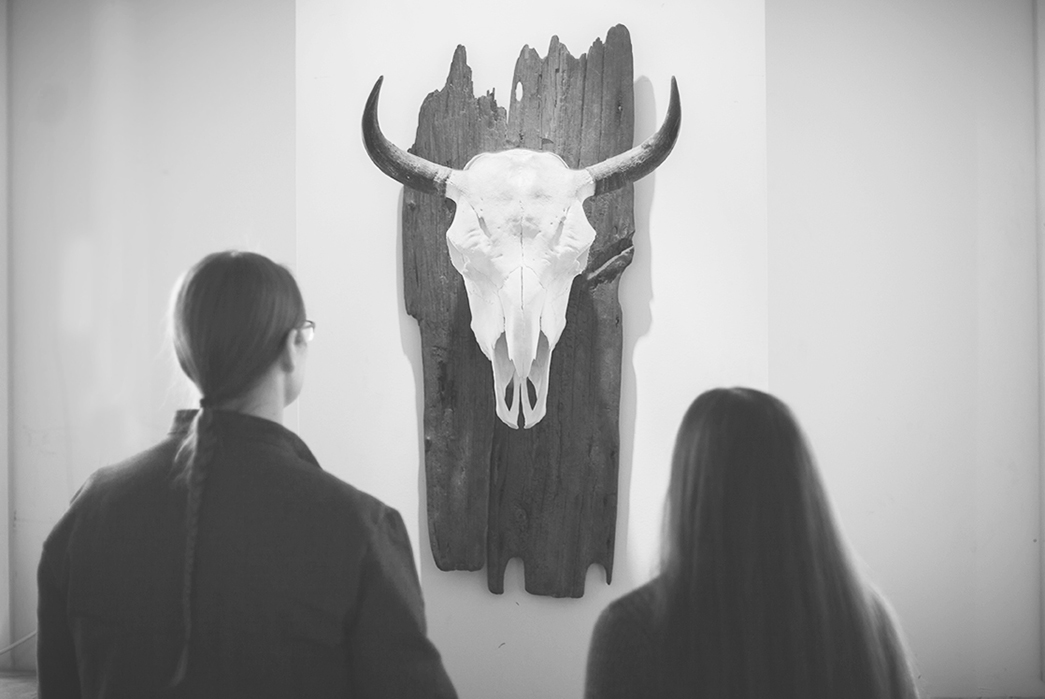
AM: So, my wrench that I want to throw in that is this: there’s this supportive environment you’re in, but there are also other people using Native imagery in a way that I’m sure can be frustrating.
EB: I would say it’s more offensive than frustrating. I hope that our presence, as Native people, has been able to elevate American Indian design as a real honest-to-God thing, as opposed to something that can be openly plagiarized. We’re pretty forthright about the open plagiarism of American Indian design and the harms of cultural appropriation. Having an open dialogue, as opposed to a shouting match, makes more sense around issues like the appropriation and plagiarism of American Indian designs. It is frustrating, but I think our voice and our presence in the niche may help people realize that it isn’t right to openly copy and exploit American Indian customs, culture, and design.
I think it’s crazy when people will spend hundreds and hundreds of dollars on Native American-inspired jewelry—like imitation “Navajo” jewelry or fabrics—when you can buy authentic, and in my opinion, better jewelry from a Navajo or from an American Indian artisan. Why settle for plagiarism or “Native-inspired” when you can buy authentic elements that have a real connection? Things that have real spirit. We’ve had this conversation with shops and helped connect them with authentic Native American artisans…especially with jewelry.
AM: So, that piece that your dad had—that original jacket you were making. What was that?
EB: The Heritage Coat. It was the first apparel item in our collection; a barn coat style. We aimed to make the coat from the materials that were available when our great-grandparents were alive. I designed the Heritage Coat after my great-great-grandpa. It was a thought experiment since I never got to meet him. He made the transition from hunter-gatherer to agrarian and he fought tooth and nail ’til the day he died learning how to farm and learning a different way of life. He would have worn clothes like this one and he was the inspiration behind the thought experiment.
We made it of Cone Mills denim, the same kind of denim that would have been made in the early 1900s. We used the most sturdy blanket lining we could find as well as American thread and notions. We made sure the labels were made in the U.S.—everything. We’re pretty nutty. The first year was a little nuts with a steep learning curve. To top it off, we put it in a cedar box. It was such a great touch. As you slid open the box there’d be all this cedar powder and the coat would smell like cedar. Cedar is also spiritually significant to our families.
AM: So what’s cool to me is these pieces are conjuring, for you, a specific person more than a concept.
EB: Every single one of the pieces in our collection is inspired by one of our relatives. We haven’t been able to meet all of the relatives, relatives that we know of because of having family stories passed down. Designing with a family story in mind is a way for us to create a tactile piece to accompany an oral tradition. We don’t want to forget or lose those stories and if you have something tactile to pass down about that relative, it’s a way we can leave a legacy for our family. It’s something they may literally hold onto that has a true story of theirs woven into it.
People ask us if we’ll ever sell the brand and we can’t, it’s not an option. We’ll shut down Ginew before we sell it. Ginew is the story of us and our family and the stories are woven into every garment.
AM: It’s just too personal.
EB: Exactly. So personal.
AM: What new pieces are coming that you’re excited about?
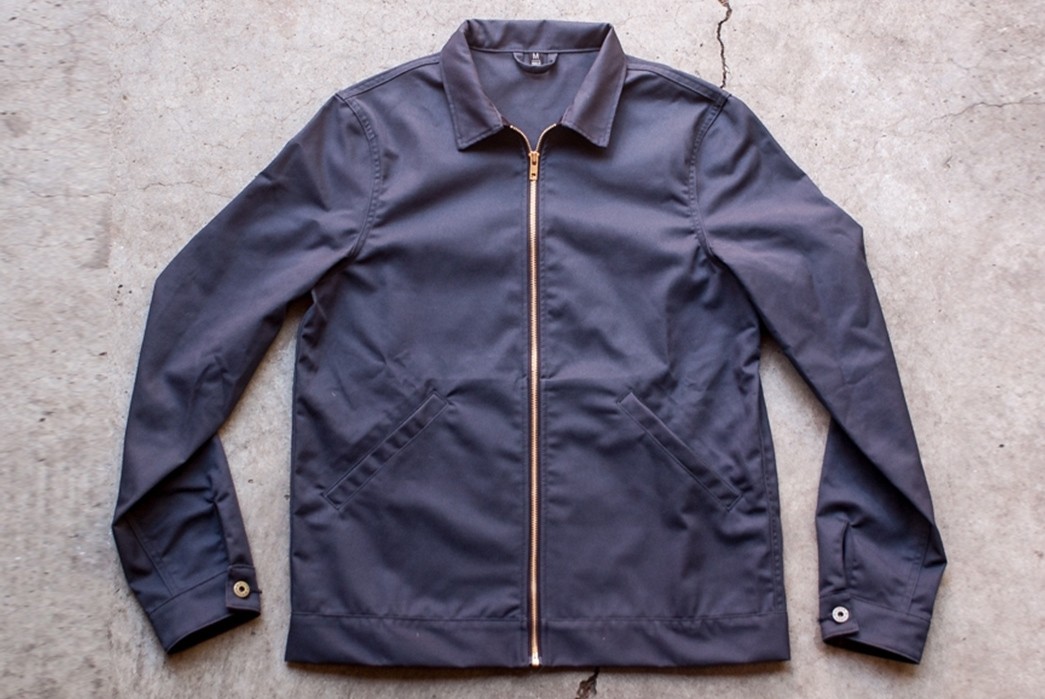
The original Mohican Crew Jacket. Erik would probably prefer you wait and get the new satin-lined, raglan sleeve version. Image via Ginew.
EB: We’re making slight modifications to the Mohican Crew Jacket. We want to make it more refined. We’re putting a super buttery satin lining in it. We’re changing the cut ever so slightly. I want it to be a piece that someone can wear to work, to play, or in the office. We’ve had a ton of positive feedback on it and now we’re making it better. This is one thing about me: we don’t look at something and don’t automatically see exactly what is right about it, we look at it like, “that is incorrect.”
AM: So things are morphing over time in accordance with your gut feeling?
EB: Correct. Both of us are over-the-top list-makers and box-checkers. We have checklist after checklist after checklist. We will also be releasing an auto club coat. The new items will look a bit different with a new feel than previous items in the collection.
One of our uncles just retired after 37 years. His first job, a job he loved, was working as an auto parts service tech. Later, he worked at an insurance company and I think he hated his job. Five years back, he left his insurance job and went back to working at an auto parts shop. He busted out his old mechanic’s jacket that he hadn’t worn in 32 years…he wore it every day the last few years of his career. After he retired, I received a box in the mail and in that box was his jacket that he wore every day as an auto parts tech. So I took this jacket and thought about what he’s done and what he did. That will become the Auto Club Coat.
AM: You guys also do jeans, so what can you tell me about those?
EB: Our jeans are named after rivers that run through our ancestral homelands. People are like, “where the hell do you get these names? Why call your jeans the Crow Wing Jean?” Well, the Crow Wing river runs right through my ancestral homelands in Minnesota. The next jean that’s coming this fall, which hasn’t been released yet, is called the Red Jean. The jean is named after the west fork of the Red River that runs right through the Mohican Indian reservation in Wisconsin. Every time we release a jean, it will be named after a river that runs through our homelands.
Blue jeans are essential. You wear them every day. And in our communities, rivers are still essential. People get food from them, rely on them for travel, and use for commerce. People go to the rivers to relax and chill out, to see what’s going on, you need them.
AM: Just like you need your blue jeans. Are you still using Cone?
EB: No, we have used the last of our stocks of Cone Denim. When I went to the Clutch show in 2014, I got to meet some of the people behind the Japanese denim mills and I really liked the representative of the Nihon Menpu mill. I started looking into their fabrics and how they wore and how they faded. Then a few years ago, we got a lucky lot with some and loved how it faded. Now we’re switching over to them almost exclusively.
AM: And there’s no American option anymore.
EB: Not that we feel comfortable with. The current USA-made denim options feel cheap. I do not have much confidence in the super wide loom-denim. It’s made really fast. The hand feels different and we need something that will last a long, long time.
AM: So, that’s a concession that has to be made in the name of quality?
EB: Well, our thing isn’t to make the best pieces out of the best American materials we can find. We’re trying to make the best pieces out of the best materials we can find period. We’ve gotten some criticism for why we use Pendleton instead of other wool blanket fabric options and, well…we have yet to find a wool blanket fabric that I think will hold up better than Pendleton fabric. We have blankets from Pendleton from 1911 to 1913—that is enduring. We have heard there is an American-Indian owned blanket company, it’s called Eighth Generation, which is an exciting new development for Indigenous people. We would love to learn more about them as they grow.
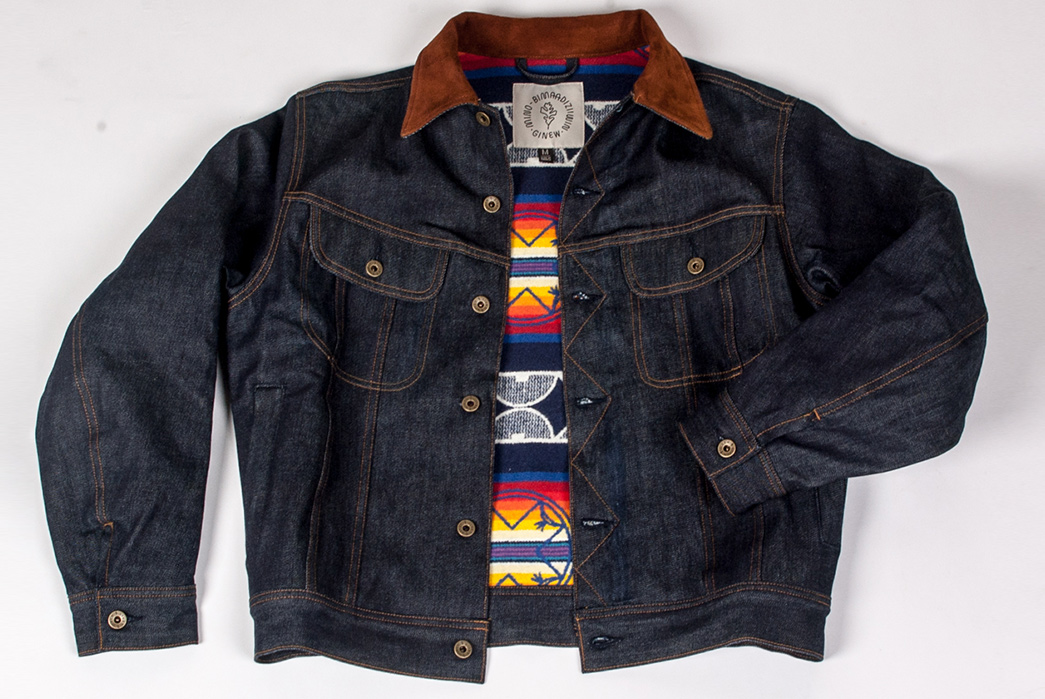
Thunderbird coat. Complete with White Oak denim, deerskin rough out collar, and a blanket lining chock-full of blessings. Image via Ginew.
AM: What’s something important that you want to share?
EB: I want your audience to understand that we are incorporating our tribal traditions into our collection, not borrowing someone else’s traditions. For instance, consider the deerskin collar and the deerskin that we include in our garments—my dad, Amanda, and I hunt the deer. For the Thunderbird Coat that we just released, 90% of the deerskin came from deer we hunted, skinned, fleshed, salted, and dried in our garage. About 10% came from others. This process limits our production. Our pieces are a bit exclusive because the total produced is limited by our commitment to using hunted deer hides.
Alternatively, the Thunderbird Jacket (the unlined version) we just released required us to expand sourcing to the community. We had to open up and ask around, “does anyone have hides?” Or talking to Phillip who tans our hides in Minnesota, I was like, “Hey Phillip, do you have any extra hides that people have shot that we can get for these jackets?” So with the Thunderbird jacket, the hides are not all hunted and prepared by us. But they’re all hunted deer from the wider community. We have a very close connection to sourcing and incorporating our traditional textiles into our collection. Deer is a traditional material for us because that’s where much of our traditional clothing came from.
AM: The hides?
EB: Deer hides specifically. There’s a whole story around the origin of deer hides being traditional and it reminds us that we are not supposed to think we are better than anyone else; to remain humble.
AM: Because you obtain that? Because that’s the work that you do?
EB: The teaching is a bit more than that. There’s a teaching in our community that talks about how families are were divided up a long time ago. It’s similar to the Western or Christian way people have last names, like Jacob Smith. Smith comes from their family. On both Amanda’s and my side of the family, we have clans, each of which is basically a big family. You get your clan from one of your parents. Your clan is your relatives.
There are social norms. For instance, one is not supposed to marry someone from the same clan (same family). A long time ago, there was one group or clan that began ignoring this social norm. They began to think they were better than everyone else and started to marry among each other. The Creator said, “that’s not our way, you’re disobeying the teachings.” Ultimately, that clan was transformed into the deer. The teaching is that we are related to deer, they used to be Ojibwe people who became the deer. For the rest of their existence, their role would be to provide meat and clothing to the community. In this spirit, deer give themselves to you, to remind you that they are part of the community. And it reminds you that nobody else is better than anyone else is better. Stay humble.
Our family has been hunting deer since time immemorial…and it goes much, much deeper than making a leather accent. The inclusion of traditional materials, it allows us to express who we are in the clothes we wear every day. Other brands will make up a kitschy story or blatantly plagiarize another culture, but what we are doing is different, I think. It’s very personal…we are sharing our culture in the collection.
AM: What are the important characteristics of deer hide that you look for?
EB: A deer’s skin is a light grayish color when you don’t add any pigments or dyes. But if you do the classic vegetable tanning, or soak it in a swamp or a bog, it takes on a different look. Deerskin is buttery soft and delicate, compared to cow hides. Have you ever heard of the saying “fish discovers water last?”
A fish in water may not realize water even exists at all until it’s pulled out of water in the last moments of its life. So, like you, as an enthusiast, who’s into apparel history, denim history, elements of this niche, etc… what do you find interesting or compelling about Ginew? How’d you hear about us? Because we’re pretty obscure.
AM: I’ve heard of you before, I recognize all of the pieces in the line. And I think what’s clicking with me now is the total absence of a gimmick that can exist in other brands.
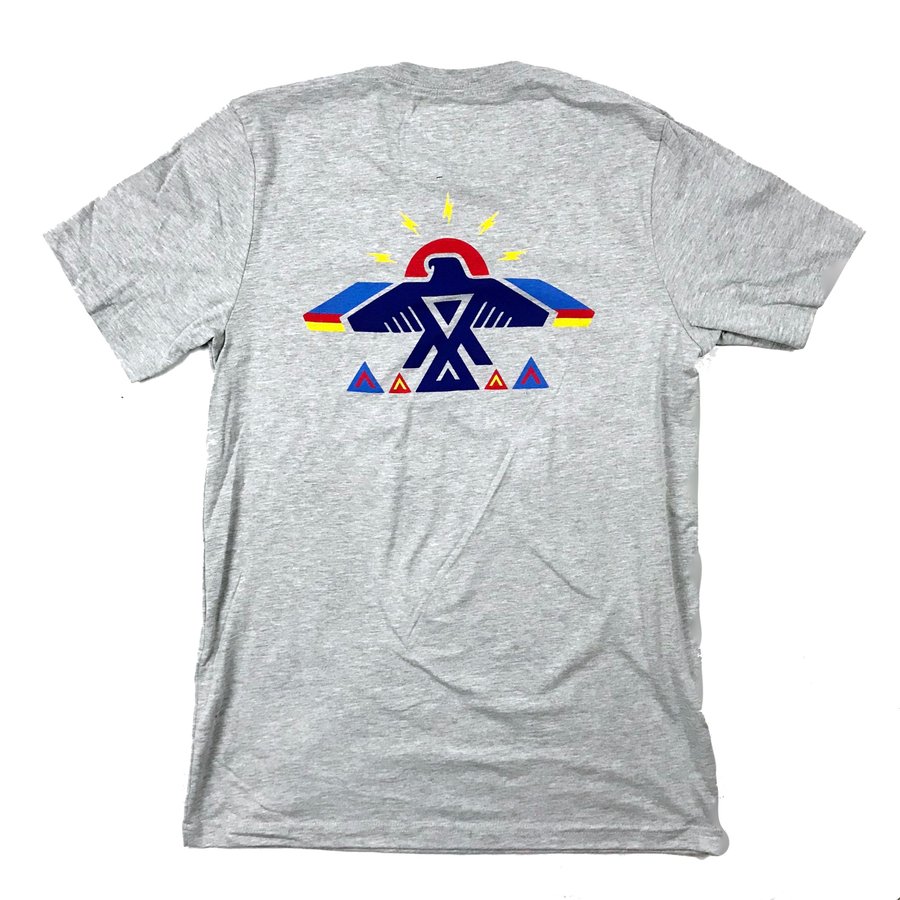
Ginew Thunderbird t-shirt. Image via Beyond Buckskin.
EB: Thanks. That is important to us. Others are putting Thunderbirds all over their collection, branding, and marketing. But the Thunderbird is a symbol of my tribe that I’ve seen since I was a little kid. That symbol—the Ojibwe Thunderbird. Carved in a tree, painted on the side of a garage, on a sign at a tribal building, on someone’s car. I’ve seen that symbol my whole life.
And when I was in Marfa, it was the logo of a restaurant there…an Ojibwe Thunderbird in far out West Texas. But that’s one of the symbols of our tribe. I have no idea how old the symbol is even, it’s just always been and there are different forms of it across many cultures indigenous to North America.
AM: I think that’s what’s also crazy: how loaded so much imagery is. And I think that we’ve been desensitized and disconnected from the true meaning of these images and their importance. So I like this because it’s reorienting me towards what stuff really is. I also like that there’s a tangible person woven into the piece. And that Mohican Crew jacket story, that’s super cool.
There are so many people who are using Native imagery in uninspired, unenlightened ways. How do non-native people wear these things or guide themselves?
EB: Buy from people who are Native. Buy from artisans and designers who are incorporating the spirit of their culture into their work, because you can. There’s a whole list that gets put out. There are high fashion and jewelry to people who design t-shirts and hats. But there’s a list, there’s a buy native list. And we’re proud to be a part of that list.
One of the higher fashion brands is b. Yellowtail, based out of LA, she incorporates herself and her culture into her collection. We really appreciate this. One day I hope to meet her. Amanda finds her very inspiring because she’s an urban, native woman who’s telling her contemporary story through her very contemporary fashion line. She has a truly inspired collection.
AM: Let’s say I find that piece that I like from one of those jewelry designers. What I’d be paranoid about is if it’s appropriative. Or is it not, because a designer is putting it out there?
EB: I guess the thing that’s hardest for me is that people, especially buyers and designers, know better. And there are major tastemakers in this country who know better. They are smart, intelligent, kind people…who do know better.
AM: And they know you.
EB: Oh totally, and they’ve known us for years. But they still buy what sells…even at the price of plagiarizing a culture. I’m talking buyers at this point. They buy items that are at best, plagiarized, which is nuts. And the thing is, they know it. That’s the hardest part for me. The buyers can’t claim ignorance, they’re not dumb people. Buyers and consumers continue to choose the bottom line on these plagiarized (“Native-inspired”) pieces, versus choosing what we, as Indigenous people, believe is the right thing to do. If you’re going to sell a $600 piece of “Navajo” jewelry, maybe it should actually be made by a Navajo artisan.
It’s tough to keep running into cultural appropriation. Some stores have large iconographic images of tribal chiefs or leaders. It is definitely an awkward display. For instance, one store I went into had this huge image of an iconic Native chief. And I know that chief’s great-great-grandson. He still carries the same last name. And it feels gross to see his family put on display as an appropriated image or mural as part of a “vibe.”
AM: It’s totally divorced from reality for them.
EB: Right. They have zero connection to the person or the family, yet the shop or brand does as they please with little regard for culture.
But then there’s the flip side. There’s a shop in California somewhere and that dude’s grandpa has a personal connection to the image. His grandfather either took the photo or painted that piece, which is rad, but there’s a real connection. You know what I mean? Do you understand the difference? His grandfather’s relationship with the subject and the image is a tie to a real story. And to me, that’s awesome; that is real.
Whereas others are carelessly slapping an Indian on a wall, which feels disconnected to me because the relatives of the chiefs in their murals are still alive. Their families are still alive. The culture is alive. That’s the soulless act of cultural appropriation, taking from a living culture and exploiting it. I don’t feel like we’re appropriating blue jeans as jeans are ubiquitous to our own lived experience. It’s hard because I feel you know cultural appropriation when you see it, but you can’t quite define it in all circumstances.
AM: I don’t feel like anyone is appropriating blue jeans, but I feel like your brand is one of the most honest that I’ve encountered. That is, that you have a person in mind that you know when you design something. Every piece is a person. So it’s not just a period of time or a Pinterest mood board.
EB: It’s like naming a jean “The Clint.”
AM: Indigofera?
EB: Yeah, yeah, exactly. Clint, Dawson, Heff…each item is named after all these people they’re inspired by and love, which I think is a great way to demonstrate what they look to and tell a story. I wear Indigofera. They’re really good friends of ours. When we go to Sweden, we stay at their house, hang out, drink great wine and tell stories.
At the heart, that’s been the greatest gift of all with Ginew. Outside of being able to tell our story in a way that will last long after we’re gone, the relationships we’ve been able to build with peers, dreamers, and like-minded individuals…that has been the greatest gift.
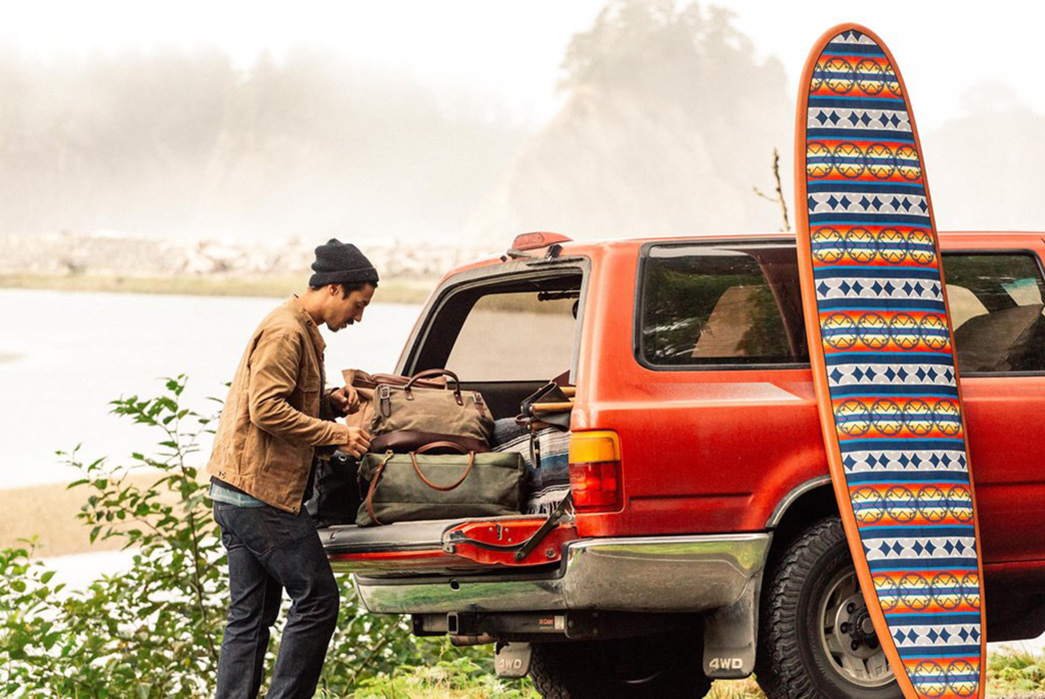
To learn more and see Ginew’s entire collection, visit their website.

